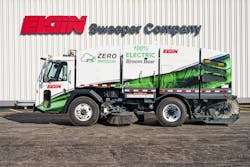What’s the Difference Between Diesel and Electric Sweepers?

The electrification of transportation is revolutionizing the way the world moves. Electric vehicles are gaining popularity in the consumer market while electric buses and trains are becoming more prevalent in the mass transit sector.
Electrification is coming for the airfield as well as airports look for opportunities to cut costs and emissions. A variety of electric sweepers are coming to the market, so we take a look at the basics of the technology and what to consider when making an investment for your airport.
Diesel Powerplants Explained
Diesel is the mainstay of heavy-duty equipment in North America. The powerplants use high compression ratios to offer increased power loads at low RPMs. The additional power offers high torque volumes for equipment used for moving high loads of force.
Diesel powerplants run on an internal combustion format without the use of spark. Air and fuel are heated by glow plugs when the engine is cold and heat created by compression of air creates combustion in the cylinder, which creates power. This high compression ration creates better fuel efficiency than other internal combustion engines while offering more overall power. Diesel powerplants utilize direct injection into the cylinder to aid in combustion.
Diesel fuel is less refined and thicker than most other fossil fuels. It provides more energy than other fossil fuels, but also has a higher rate of particulate pollution. All diesel fuel sold today is ultra-low sulfur and has no more than 15 ppm of sulfur to address emissions challenges. Biodiesel created from organic material is available in some areas. This fuel is often blended with regular diesel fuel to offset pollution challenges.
Diesel Fuel Cost is Subject to Market Fluctuations
The high capacity of fuel tanks and continuous usage of diesel equipment at an airport necessitates the construction of a fuel farm on the property. Tanks can vary in size of more than of 50,000 gallons.
How Do Electric Motors Work?
Electric motors use electromagnetism to turn electricity into energy. The energy creates torque to power vehicles like any standard motor.
The units have far less moving parts than a traditional internal combustion engine. This means minimal to no maintenance to the motor itself.
Power is transmitted to the motor from a battery. The powers a coil within the motor to create the electromagnetic field, which then creates mechanical power that moves the vehicle.
How Does Electric Equipment Work?
Elgin Sweeper Product Manager Tim Letts says Electric equipment like the Elgin Electric Broom Bear are a truck-mounted sweeper utilizing an all-electric chassis. Driving the unit is very similar to driving an EV car. The acceleration is quick, so you will need to adjust to a new driving dynamic.
Regenerative breaking slows down the vehicle without applying the brakes while putting energy back into the battery. The additional weight of the electric chassis is taken into consideration when developing the sweeper so it has the same payload capacity as a traditional sweeper.
How Does Recharging Work?
The Electric Broom Bear is a standard SAE J1772 CCS, compatible with both level 2 or level 3 chargers. Level 2 AC charging enables overnight charging while Level 3 DC-DC charging enables fast charging. Letts recommends working with infrastructure specialists like local power supplier to determine which charging station can be supported.
Costs are dependent on local power rates, giving more stability to the cost to recharge compared to fossil fuel-powered equipment.
Some manufacturers may also removable batteries as a charging solution. These setups allow crews to quickly remove a low battery on the field and replace it with a fresh one. This method allows an airport to set up charging for batteries instead of plugging a vehicle into a wall.
Both charging options are based on mature technology and can be more beneficial depending on the needs of the airport.
Is Maintenance Different?
Chassis maintenance is minimal due to the electric power train and the sweeper maintenance is the same as a standard or hybrid models.
Is It Right for My Airport?
What you’re using to sweep the tarmac and runway is going to be different than what you use to sweep the nearby roads and parking areas. Typically at airports the sweepers are picking up materials such as pea gravel, sand, small metal objects and small debris. There’s also glycol recovery to consider before it enters storm water runoff.
As such, the most important question before considering the power source is considering the application. Once that is determined, then it’s time to look at the power source. As states, companies and airports move to achieve certain sustainability goals, Letts expect to see the utilization of more hybrid and all-electric sweepers.
About the Author
Joe Petrie
Editor & Chief
Joe Petrie is the Editorial Director for the Endeavor Aviation Group.
Joe has spent the past 20 years writing about the most cutting-edge topics related to transportation and policy in a variety of sectors with an emphasis on transportation issues for the past 15 years.
Contact: Joe Petrie
Editor & Chief | Airport Business
+1-920-568-8399
>> To download the AviationPros media kits, visit: Marketing Resource Center
>>Check out our aviation magazines: Ground Support Worldwide | Airport Business | Aircraft Maintenance Technology
